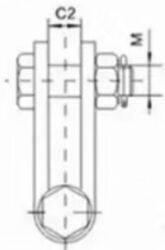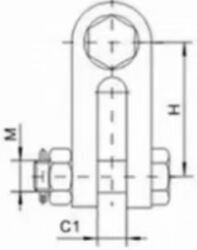1. High-Quality Materials
Typically manufactured from high-strength aluminum alloy or high-quality carbon steel. Aluminum alloy materials are lightweight and corrosion-resistant; carbon steel materials offer high strength and toughness, capable of withstanding large tensile forces. Both are generally treated with anti-corrosion processes such as hot-dip galvanizing to adapt to complex outdoor environments.
2. Right-Angle Structure
Features a unique right-angle shape, cleverly adapting to changes in tower structure and line routing to achieve precise positioning and installation on towers with limited space.
3. High Machining Precision
Manufactured with precise dimensions and higher-than-rated mechanical load capacity, ensuring accurate and stable connections.
1. Secure Connection
Fastened to towers, insulator strings, etc., using high-strength bolts or other specialized connecting accessories, ensuring a tight and corrosion-resistant joint that can operate stably for long periods in harsh outdoor environments.
2. Flexible Redirection
With its right-angle connection orientation, it offers flexible redirection and strong adaptability, capable of changing connection directions as needed to effectively transmit electrical loads.
3. Maintenance-Friendly
Easy to install and disassemble. During line inspections, insulator replacement, and other maintenance tasks, workers can use the connection points of the right-angle hanging plate to easily hang repair tools or temporarily secure equipment. Its stable structure can bear a certain weight, ensuring safe and orderly maintenance operations.
1. Connection and Positioning
As a critical component in overhead power lines for connecting towers to insulator strings or other line components, one end is fixed to the tower cross-arm via bolts or other connectors, while the other end connects to the insulator string. It links vertically positioned towers with horizontally arranged insulators and conductors to form a reliable connection, ensuring precise and secure positioning of the conductors.
2. Tension Adjustment
By fine-tuning the installation angle and position, it assists in adjusting the tension distribution of the conductors, preventing faults such as conductor breakage caused by excessive local tension, and enhancing the safety and reliability of overhead lines.
3. Route Redirection
Plays a key role when overhead lines need to turn or change direction, effectively guiding the conductor’s path to ensure stable current transmission along the predetermined route.


| General design model | Model | ALL SIZE(MM) | Nominal breaking load(KN) | Weight(kg) | |||
| C1 | C2 | M | H | ||||
| Z-7 | 20 | 20 | 16 | 80 | 70 | 0.70 | |
| Z-10 | 20 | 20 | 18 | 80 | 100 | 1.00 | |
| Z-12 | 24 | 24 | 22 | 100 | 120 | 1.80 | |
| Z-16 | 26 | 26 | 24 | 100 | 160 | 2.38 | |
| Z-21 | 30 | 30 | 27 | 120 | 210 | 3.50 | |
| Z-25 | 33 | 33 | 30 | 120 | 250 | 4.80 | |
| Z-0780 | 20 | 20 | 16 | 80 | 70 | 0.70 | |
| Z-1080 | 20 | 20 | 18 | 80 | 100 | 1.00 | |
| Z-12100 | 20 | 24 | 22 | 100 | 120 | 1.80 | |
| Z-16100 | 22 | 26 | 24 | 100 | 160 | 2.90 | |
| Z-21100 | 24 | 26 | 24 | 100 | 210 | 3.40 | |
| Z-25110 | 28 | 30 | 27 | 110 | 250 | 3.80 | |
| All measurements provided are manually obtained and may contain slight tolerances. Final dimensions shall be subject to the physical product. | |||||||
Our professional sales team are waiting for your consultation.